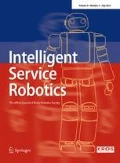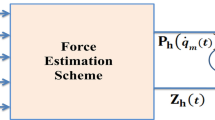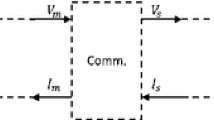Abstract
This paper addresses the problem of asymptotic stability and position tracking in nonlinear teleoperation systems interacting with non-passive operator and environment. A nonlinear control law which is designed based on Interconnection and Damping Assignment Passivity-Based Control (IDA-PBC) scheme, uses the positions and velocities of the joints of manipulators to provide asymptotic stability of tracking errors. Using the Lyapunov–Krasovskii theorem, sufficient conditions are derived in terms of computationally amenable Linear Matrix Inequalities (LMIs), to tune the controller parameters in the presence of asymmetrical varying time delay in the communication channel. The proposed controller synthesis methodology requires no known passive part in the dynamical model of interaction forces. Moreover, using the integral control notion, the asymptotic stability of the synchronization errors is assured. Comparative simulation results are presented to demonstrate the superiority of the proposed method compared to some rival ones. Finally, experimental results from a laboratory teleoperator are reported to confirm the applicability of the introduced scheme.



















Similar content being viewed by others
References
Hokayem PF, Spong M (2006) Bilateral teleoperation: an historical survey. Automatica 42(12):2035–2057
Ying Z, Guangming S, Zhong W, Huiyu S, Yong Z (2016) Bilateral teleoperation of a group of mobile robots for cooperative tasks. Intel Serv Robotics 9:311–321
Banthia V, Zareinia K, Balakrishnan S, Sepehri N (2017) A Lyapunov stable controller for bilateral haptic teleoperation of single-rod hydraulic actuators. J Dyn Syst Meas Cont 139(11):111001–111016
Arcara P, Melchiorri C (2002) Control schemes for teleoperation with time delay: a comparative study. Rob Autonom Syst 38(1):49–64
Nuno E, Basanez L, Ortega R (2011) Passivity-based control for bilateral teleoperation: a tutorial. Automatica 47(3):485–495
Hashemzadeh F, Hassanzadeh I, Tavakoli M (2013) Teleoperation in the presence of varying time delays and sandwich linearity in actuators. Automatica 49(9):2813–2821
Hu HC, Liu YC (2017) passivity-based control framework for task-space bilateral teleoperation with parametric uncertainty over unreliable networks. ISA Trans 70:187–199
Lima MV, Mozelli LA, Neto AA, Souza FO (2020) A simple algebraic criterion for stability of bilateral teleoperation systems under time-varying delays. Mech Syst Sig Proc, Available online
Nuno E, Basanez L, Ortega R, Spong M (2009) Position tracking for non-linear teleoperators with variable time delay. Int J Robot Res 28(7):895–910
Kostyukova O, Vista FP, Chong KT (2019) Design of feed forward and feedback position control for passive bilateral teleoperation with delays. ISATrans 85:200–213
Polushin I, Liu P, Lung C, Dien On G (2010) Position-error based schemes for bilateral teleoperation with time delay: theory and experiments. Trans ASME J Dyn Syst Meas Cont 132:031008–031008–031008–031011
Sarajchi MH, Ganjefar S, Hoseini SM, Shao Z (2019) Adaptive controller design based on predicted time-delay for teleoperation systems using Lambert W function. Int J Cont Autom Syst 17(6):1445–1453
Nuno E, Ortega R, Basañez L (2010) An adaptive controller for nonlinear teleoperators. Automatica 46(1):155–159
Dyck M, Jazayeri A, Tavakoli M (2013) Is the human operator in a teleoperation system passive?. In: Proceedings of IEEE international conferences on world Haptics conference, pp 683–688
Atashzar SF, Polushin IG, Patel RV (2017) A small-gain approach for nonpassive bilateral telerobotic rehabilitation: stability analysis and controller synthesis. IEEE Trans Rob 33(1):49–66
Hashemzadeh F, Tavakoli M (2015) Position and force tracking in nonlinear teleoperation systems under varying delays. Robotica 33(4):1003–1016
Ganjefar S, Rezaei S, Hashemzadeh F (2017) Position and force tracking in nonlinear teleoperation systems with sandwich linearity in actuators and time-varying delay. Mech Syst Sig Proc 86:308–324
Jazayeri A, Tavakoli M (2015) Bilateral teleoperation system stability with non-passive and strictly passive operator or environment. Cont Eng Pract 40:45–60
Polushin IG, Marquez HJ (2003) Stabilization of bilaterally controlled teleoperators with communication delay: an ISS approach. Int J Cont 76(8):858–870
Polushin IG, Liu PX, Chung-Horng L (2006) A control scheme for stable force-reflecting teleoperation over IP networks. IEEE Trans Syst Man Cyber 36(4):930–939
Hua C, Liu PX (2009) Convergence analysis of teleoperation systems with unsymmetric time-varying delays. IEEE Trans Circuits Syst II Express Briefs 56(3):240–244
Lozano R, Chopra N, Spong MW (2007) Convergence analysis of bilateral teleoperation with constant human input. In: Proceedings of American control conferences marriott marquis hotel at times square, pp 1443–1448
Islam S, Liu P, El Saddik A (2014) Nonlinear control for teleoperation systems with time varying delay. Nonlin Dyn 76:931–954
Islam S, Liu P, Saddik A, Dias J, Seneviratne L (2015) Bilateral shared autonomous systems with passive and nonpassive input forces under time varying delay. ISA Trans 54:218–228
Li W, Ding L, Gao H, Tavakoli M (2020) Haptic tele-driving of wheeled mobile robots under nonideal wheel rolling, kinematic control and communication time delay. IEEE Trans Syst Man Cybern Syst 50(1):336–347
Ortega R, García-Canseco E (2004) Interconnection and damping assignment passivity-based control: a survey. Eur J Cont 10(5):432–450
Liu X, Tao R, Tavakoli M (2014) Adaptive control of uncertain nonlinear teleoperation systems. Mechatronics 24:66–78
Astrom KJ, Hagglund T (1995) PID controllers: theory, design, and tuning. Instrument society of America, 1995
Author information
Authors and Affiliations
Corresponding author
Additional information
Publisher's Note
Springer Nature remains neutral with regard to jurisdictional claims in published maps and institutional affiliations.
Appendix
Appendix
The simulations have been carried out by executing Algorithm in Matlab®.

In the experimental setup, controllers and communication channel are realized in Matlab® similar to simulation algorithm except that the interaction forces act directly on the robots in the real world and the states of system (i.e., \( q_{i} ,\dot{q}_{i} \)) are measured by the sensors. The control signals after calculation in the program are sent to DC motors by Arduino Uno which is supported by Arduino Hardware support package toolbox in Matlab®. Algorithm 2 describes this procedure.

Rights and permissions
About this article
Cite this article
Ebrahimi Bavili, R., Akbari, A. & Mahboobi Esfanjani, R. Passivity-based control of nonlinear teleoperation systems with non-passive interaction forces. Intel Serv Robotics 13, 419–437 (2020). https://doi.org/10.1007/s11370-020-00327-6
Received:
Accepted:
Published:
Issue Date:
DOI: https://doi.org/10.1007/s11370-020-00327-6




